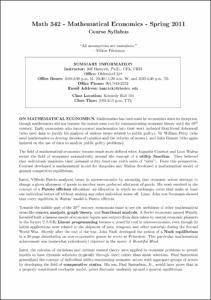Please use this identifier to cite or link to this item:
http://hdl.handle.net/10267/15790| Title: | MATH 342-01, Mathematical Economics, Spring 2011 |
| Authors: | Hamrick, Jeff |
| Keywords: | Syllabus;Curriculum;Academic departments;Text;Mathematics and Computer Science, Department of;2011 Spring |
| Issue Date: | 12-Jan-2011 |
| Publisher: | Memphis, Tenn. : Rhodes College |
| Series/Report no.: | Syllabi CRN;21254 |
| Abstract: | Mathematics has been used by economists since its inception, though mathematics did not become the mainstream tool for communicating economic theory until the 19th century. Early economists who incorporated mathematics into their work included Gottfriend Achenwall (who used data to justify his analysis of various issues related to public policy), Sir William Petty (who used mathematics to develop theories of taxation and the velocity of money), and John Graunt (who again insisted on the use of data to analyze public policy problems). The field of mathematical economics became much more defined when Augustin Cournot and Leon Walras recast the field of economics axiomatically around the concept of a utility function. They believed that individuals maximize their personal utility functions (with units of “utils”). From this perspective, Cournot developed a mathematical model for duopolies and Walras developed a mathematical model of general competitive equilibrium. Later, Vilfredo Pareto analyzed issues in microeconomics by assuming that economic actors attempt to change a given allotment of goods to another more preferred allotment of goods. His work resulted in the concept of a Pareto efficient allocation: an allocation in which no exchanges occur that make at least one individual better off without making any other individual worse off. Later, John von Neumann showed that every equilibria in Walras’ model is Pareto efficient. Towards the middle part of the 20th century, economists came to see the usefulness of other mathematical areas like convex analysis, graph theory, and functional analysis. A Soviet economist named Wassily Leontief built a famous model of economic inputs and outputs from data taken by central economic planners in the former U.S.S.R. Linear programming became a powerful tool in microeconomics, even though its initial applications were related to the shipment of men, weapons, and other materials during the Second World War. Shortly after the end of the war, John Nash developed the notion of a Nash equilibrium in a 28-page dissertation on non-cooperative games he wrote at Princeton. This particular mathematical achievement was (somewhat ridiculously) depicted in the movie A Beautiful Mind. Later, the calculus of variations and optimal control theory were applied to economic problems to permit models to have dynamic solutions (typically through time) rather than static solutions. Paul Samuelson generalized the concept of individual utility-maximizing economic actors with aggregate groups of actors by developing the field of comparative statics. His son, Paul Samuelson, Jr., would later prove that in a properly constituted stochastic model, prices fluctuate randomly around a general equilibrium. Today, the field of economics is utterly dominated by mathematical and statistical methodologies. It is increasingly difficult to find an academic paper in a reputable economic journal that does not use mathematics or econometrics in a meaningful fashion. Nonetheless, the “mathematization” of economics has been criticized by many economists. Friedrich Hayek, a notable member of the anti-mathematical (and really, anti-data) “Austrian” school of economic thought, argued that mathematical formalism could never properly account for informational limitations faced by real-world economic actors. Karl Popper despised the invasion of economics by mathematics, arguing that axioms, theorems, and proofs do not really subject themselves to empirical refutation—turning the entire field of economics into a wobbling tautology. J.M. Keynes himself said that many concepts in mathematical economics are “merely concoctions which are as imprecise as the initial assumptions upon which they rest...[mathematical economics is] a maze of pretentious and unhelpful symbols.” |
| Description: | This syllabus was submitted to the Office of Academic Affairs by the course instructor. Uploaded by Archives RSA Josephine Hill. |
| URI: | http://hdl.handle.net/10267/15790 |
| Appears in Collections: | Course Syllabi |
Files in This Item:
| File | Description | Size | Format | |
|---|---|---|---|---|
| 2011_Spring_Math_342-01_21254.pdf | 46.33 kB | Adobe PDF |  View/Open |
Items in DSpace are protected by copyright, with all rights reserved, unless otherwise indicated.